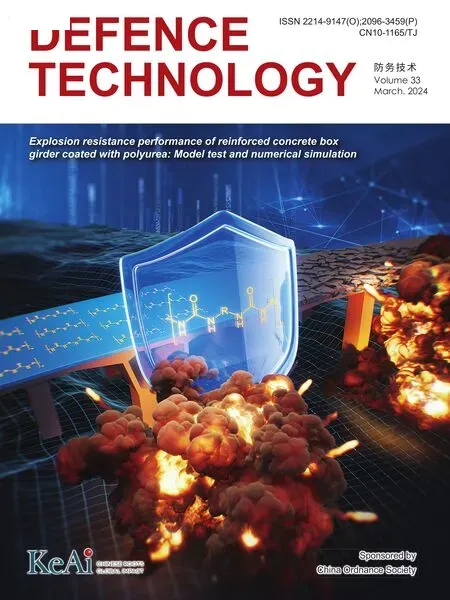Surface morphologies of Mg-Gd alloy particle during its reactions with O2 and Teflon
Yifn Li , Hongto Yng , Aifeng Jing , Dongming Song , Ynhun Li ,*
a Department of Chemical Engineering, Nanjing University of Science and Technology, Nanjing 210097, China
b Xi'an Modern Chemistry Research Institute, Xi'an 710065, China
c Southwest Technology and Engineering Research Institute, Chongqing 400039, China
Keywords:Mg-Gd alloy Energetic materials Morphology EDS GdOF
ABSTRACT Mg-Gd alloy particle has exhibited its unique combustion properties as the fuel of Mg/Teflon/Viton(MTV).Mg-Gd alloy/Teflon/Viton (MGTV) could burn at lower ambient pressure than MTV.To further investigate the reaction of MGTV in air, it was investigated via thermo gravity-differential scanning calorimetry (TG-DSC).Meanwhile, the morphologies and element distributions on the alloy surface during the reaction of MGTV in air were investigated via scanning electronic microscope-mappingelectronic differential spectrometer.Meanwhile, a similar experimental protocol on the Mg-Gd alloy particle during oxidation was also applied.The results showed that owning to a protective oxide shell,the onset oxidation temperature of Mg-Gd alloy is higher than Mg.However, the onset oxidation temperature of the exceeded Mg-Gd alloy in MGTV is significantly lower than that of the exceeded Mg in MTV.It was due to the existence of GdOF, which could significantly lower the oxidation temperature of the exceeded fuel.Furthermore,a possible reaction mechanism was proposed.The fascinating oxidation properties of Mg-Gd alloy suggested its promising applications in energetic materials.
1.Introduction
As one of the most reported metallic structure materials recently,Mg-Gd alloy and a series of rare earth alloys have drawn much attentions owing to their enhanced hardness, tensile strength, and superior oxidation resistance [1-6].Gadolinium reacts with magnesium to form rare earth compounds, including Mg5Gd.These rare earth compounds have a high melting point and thermal stability, which can effectively prevent crystal boundary slip and dislocation and thereby strengthen thermal stability.
Meanwhile, in energetic materials, rare earth elements have been applied for various purposes, including catalyst [7-10], oxidizers [11], energetic ionic liquids [12], solid oxide fuel cells(SOFCs), solid oxide electrolysis cells (SOECs) [13], and thermites[14].Furthermore, when rare earth, specifically Mg-Gd alloy particle, applied as the fuel of Mg/Teflon/Viton (MTV) [15], the pyrotechnic composite, Mg-Gd alloy/Teflon/Viton (MGTV), exhibits several advantages.In details,MGTV could stably burn under lower environment pressure, which MTV could not.Furthermore, when MGTV(Gd:15 wt%)burn in open air,the radioactive properties are better than Mg-Al alloy (Al: 50 wt%)/Teflon/Viton.However, the reaction mechanism of MGTV in air and the oxidation properties of Mg-Gd alloy exceeded to be discussed.
Therefore, to obtain a comprehensive understanding of the reactions and morphologies of both MGTV and Mg-Gd alloy particles during oxidation, a series of experiments were conducted.Firstly,the reaction of MGTV in air at different heating rates were investigated to analyze the reaction process.Furthermore, an ex-situ macro-micro morphological analysis of the reaction process of MGTV using an optical microscope and scanning electron microscope were conducted.The oxidation process at different heating rates and a similar morphological analysis of the Mg-Gd alloy particles were all performed.Additionally, a detailed formation research on the reaction product of MGTV was conducted.Based on these findings, a possible catalyst mechanism for lowering the oxidation temperature of magnesium is proposed.
2.Experiment
2.1.Sample preparation
Mg-Gd alloy spherical particles (100-250 mesh, Gd: 15 wt%)were obtained from Tangshan Weihao Mg Powder Co., Ltd.(Tangshan, Henan).And Mg-Gd alloy/Teflon/Viton (MGTV) sample was prepared by the following procedure.0.5 g Viton was dissolved in acetone.5.00 g Mg-Gd alloy was thoroughly physically mixed with 5.00 g Teflon powder (5 μm, Meryer, Mw = 100.015).The Mg-Gd alloy/Teflon mixture was added into the Viton solution.Then ternary mixture was stirred fiercely until almost all of the solvent was vaporized.Later, the mixture was sorted through a 30-mesh screen.MGTV grain was later dried at the temperature of 60°C for 2 h.
2.2.TG/DSC experiments procedure
TG/DSC were performed simultaneously in Mettler-Toledo TG/DSC 3+.0.7 mg Mg-Gd alloy was loaded into a 40 μL Al2O3crucible inside the apparatus and programmed to be heated from 30 to 1200°C at the heating rate of 5, 10, 15, 20, 25, and 30 K/min,respectively.The protective gas flow was programmed as high purity Argon of 20 mL/min, and the active gas flow was programmed as high purity O2of 20 mL/min.In the case of MGTV,0.7 mg MGTV grain was tested with a same method to Mg-Gd alloy, which the active gas flow was programmed as high purity air of 20 mL/min.
2.3.The morphology characteristic on the oxidation products of Mg-Gd alloy
2.3.1.The preparation of the oxidation products of Mg-Gd alloy
To obtain the oxidation product of Mg-Gd alloy, Mg-Gd alloy spherical particle was heated in Mettler-Toledo TG/DSC 3+.0.5-1 mg Mg-Gd alloy was heated to 500,550,600,650,700,750,800, 850, 900, 950, and 1000°C at the heating rate of 10 K/min in the TG-DSC apparatus under the high purity Oxygen of the flow rate of 20 mL/min, respectively.
On the other hand, to obtain the reaction product of MGTV,MGTV grain was heated in Mettler-Toledo TG/DSC 3+.1.0-2.0 mg MGTV (single grain) was heated to 300, 400, 500, 600, 700, 800,900,1000,1100 and 1200°C at the heating rate of 10 K/min in the TG-DSC apparatus under the high purity air of the flow rate of 20 mL/min, respectively.
2.3.2.The morphology of the oxidation products of Mg-Gd alloy characterized via optical microscope
After heating in the TG/DSC apparatus,the oxidation product of Mg-Gd alloy along with the Al2O3crucible was set on the sample platform of HiROX Digital Microscope KH-7700(HiROX,Japan).The magnification was set as 50,100,200, and 300 times, respectively.
2.3.3.The morphology of the oxidation products of Mg-Gd alloy characterized via SEM-EDS-Mapping
The oxidation product of Mg-Gd alloy was gathered from the crucible and characterized by a scanning electron microscope(SEM,FEI Quanta 400FEG, 20 kV).The Energy dispersive X-ray spectroscopy (EDX, EDAX APPLO X1) was used to further discern compositional detail.
The morphology of the reaction products of MGTV in air characterized via SEM-Mapping-EDS was conducted via the same protocol to Mg-Gd alloy.
2.4.X-ray diffraction tests on the residue of MGTV after calcination
The X-Ray Diffraction tests on the residue of MGTV after calcination included two parts of the experiment: the calcination of MGTV, and the XRD tests on the residue.
The calcinations of MGTV were performed in a muffle furnace(Nabertherm P300 & P330) in air.0.2 g of the composites were heated at designed temperature of 600,700,800 and 1000°C with the heating rate of 10 K/min.
After the calcination, the solid residues were collected to perform the X-ray diffraction test(XRD,Bruker D8 ADVANCE).The wide-angle X-ray diffraction (XRD) patterns at 2θ range of 5°-90°with a continuous scan rate of 8°/min were recorded using a Bruker D2 Phaser powder diffractometer (Cu Kα radiation, λ = 1.5406 ?)with an operating voltage of 40 kV and a current flow of 44 mA.
2.5.Activities of GdOF in the residue of MGTV after calcination at 700 °C
The residue of MGTV after calcination at 700°C(Residue A)was firstly prepared by the same procedure in Section 2.4.Then, 0.10 g Residue A was firstly grinded then added into 1.00 g Mg/Teflon(50:50 in wt%).The ternary mixture was thoroughly mixed and referred as MTRA.
The thermal reactivity of MTRA was investigated via TG-DSC at 5 K/min in 20 mL/min of air.The experimental procedure was the same to Section 2.2.
3.Results and discussion
3.1.TG-DSC results of the oxidation of Mg-Gd alloy particle
Fundamentally, the oxidation process of Mg-Gd alloy particle under various heating rates was thoroughly investigated via thermal gravity-differential scanning calorimetry(TG-DSC).The results were shown in Fig.1.
The theoretical mass increase of Mg-Gd alloy was firstly calculated:
Overall, according to Fig.1, on the DSC curves of Mg-Gd alloy particle,an endothermic peak on DSC curve at 637°C was observed under each heating rate, respectively, suggesting the melting of Mg-Gd alloy.The melting point of the alloy was lower than Mg,suggesting the components, i.e.Mg and Gd, formed an alloy.It further indicated a metallic compound, Mg5Gd [16], existed.
Later, at the heating rate of 5 K/min, a sharp exothermic peak was observed at 664°C.It was due to the oxidation of Mg-Gd alloy particle.The onset temperature of this exothermic peak was 657°C and the end temperature of this peak was 687°C, resulting in a 30°C - long of its oxidation.On the co-relating TG curve, a mass increase of 51.44%was observed,which was 87.2%of the theoretical mass increase of the Mg-Gd alloy.
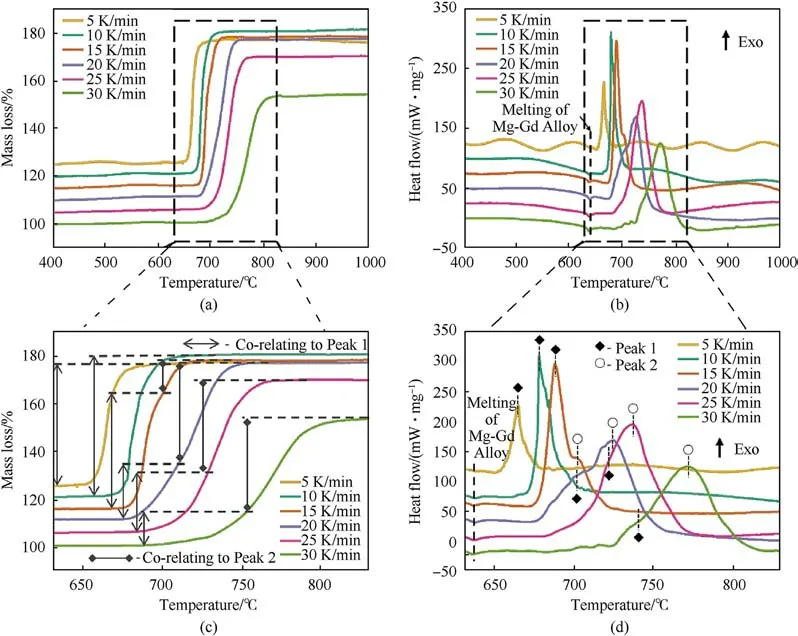
Fig.1.The TG-DSC curves of the oxidation of Mg-Gd alloy at 5,10,15, 20, 25, and 30 K/min under the atmosphere of O2.
As the heating rate rose to 10 K/min, a sharp exothermic peak was observed at 678°C.It was also due to the oxidation of Mg-Gd alloy particle.The onset temperature of this exothermic peak was 661°C and the ending temperature of this peak was 717°C,resulting in a 56°C - long of its oxidation.On the co-relating TG curve, a mass increase of 59.36% was observed, suggesting a complete oxidation process.
As the heating rate rose to 15 K/min, two exothermic peaks(Peak 1 and Peak 2) were observed at 687 and 701°C.The onset temperature of Peak 1 was 671°C and the ending temperature of Peak 1 was 698°C.The onset temperature of Peak 2 was 698°C and the ending temperature of Peak 2 was 736°C.These resulted in 63°C - long of its oxidation.On the co-relating TG curve, a mass increase of 45.36%was observed from 673 to 698°C,which was corelating to Peak 1.Continually, a mass increase of 16.14% was observed from 698 to 736°C,which was co-relating to Peak 2.The total mass increase throughout the oxidation was 61.5%.A slightly difference (2.54%) of mass increase between the total and theoretical mass increases suggested a complete oxidation process of Mg-Gd alloy.
From the heating rate of 20-30 K/min, a similar exothermic pattern, including two exothermic peaks and co-relating mass increases, was observed, respectively.These exothermic peaks and mass increases were all due to the oxidation of Mg-Gd alloy.Due to the existence of homogeneous reaction of Mg(gaseous Mg reacted with O2[17]), the oxidation reaction of Mg-Gd alloy could be complicated.Herein, the onset temperature, ending temperature,temperature-interval between the onset and ending temperature of oxidation,co-relating mass increases,and total mass increase of the oxidation of the alloy were listed in Table 1.
According to Table 1, beside of the total mass increase throughout the oxidation was equal to the theoretical mass increase,suggesting the complete oxidation of the alloy.The floating mass increases of 51.4%at 5 K/min and 52.7%at 30 K/min could be due to experimental errors.
As aforementioned results suggested,the onset temperatures of the main exothermic peaks were all higher than the melting point of the alloy, suggesting the oxidation of the alloy was a gas-liquid phase reaction.Furthermore, the onset temperatures of Mg-Gd alloy particle were all higher than the onset temperatures of the oxidation of Mg particle[17].It suggested the oxidation resistance of Mg-Gd alloy particle was better than Mg particle.
3.2.The surface morphology of Mg-Gd alloy particle during oxidation
To investigated the surface morphology of Mg-Gd alloy particle during oxidation, the alloy particle was heated at 500, 550, 600,650,and 700°C under O2,respectively.Then,the oxidation residues were firstly investigated via optical micro-scope.
The macro morphology of Mg-Gd alloy particle during oxidation was depicted in Fig.2.At 500°C,the macro morphology of the alloy appeared to be the grey spherical particles.Noteworthily, a grey particle surrounded by a circle of white product was observed.This white product could be MgO.
At 550°C, the macro morphology of the alloy did not significantly change, while a few irregular-shaped white particles were observed.These white particles were similar to the irregularshaped white particles in Ref.[17], suggesting they were MgO.This similar scenario was also observed at 600°C.

Table 1 The exothermic and mass-increase patterns of the oxidation of Mg-Gd alloy particle under different heating rate.
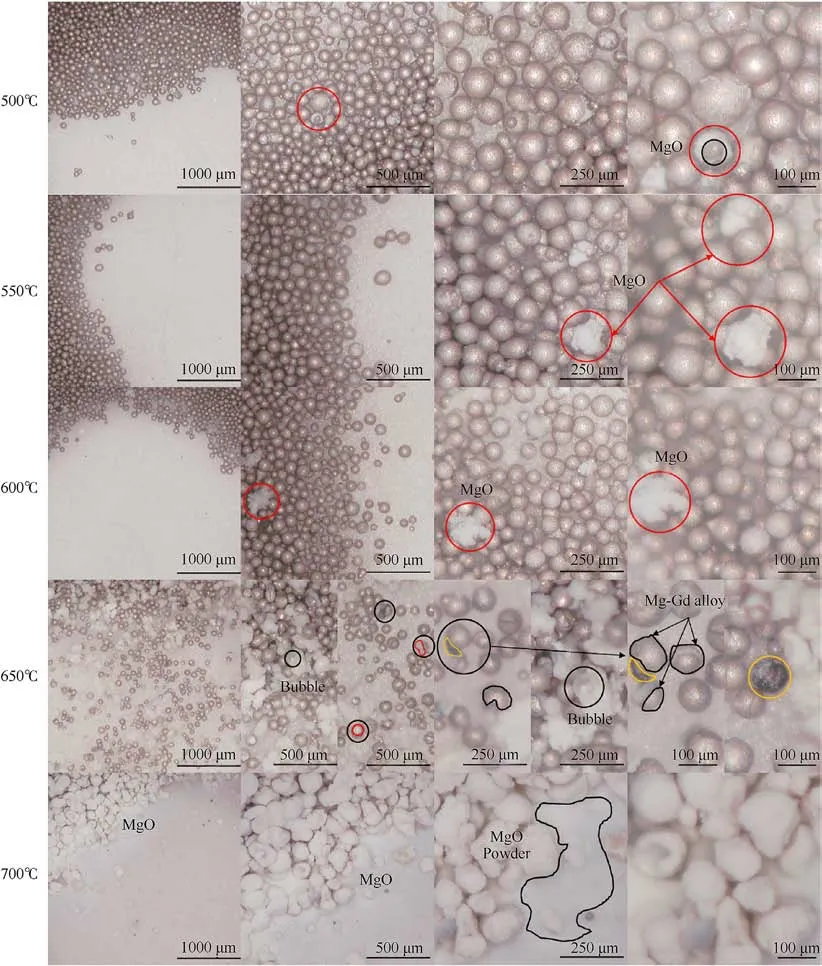
Fig.2.The morphology of the residues of the oxidation of Mg-Gd alloy at 500,550,600,650,and 700 °C magnified 50,100,200,and 300 times via Optical microscope.The white balance was set as AUTO.
As the temperature rose to 650°C, the alloy stayed light grey feature, and the amount of these white MgO particles increased.Furthermore, several new morphologies were observed on the surface of the alloy, including bubble structure on the surface of MgO, white MgO phase precipitated from the light grey alloy, and dark grey phase(yellow circled area)precipitated from the alloy.At 700°C, all originally light grey particles turned to white.Additionally, there were several white powders diffused by the white particles.The diffusion of white powders were also occurred during the oxidation of Mg [17], which was due to the reaction between gaseous Mg and O2.
These results suggested that the main oxidation began at 650°C,which could significantly change the grey spherical alloy into three types of morphologies: irregular-shaped white MgO particles,white MgO precipitated from the alloy, and dark grey phase precipitated from the alloy.At 700°C, the alloy was completely oxidized and all particles turned to white.
Furthermore,the diffused MgO powders suggested even though Mg-Gd alloy possessed a better oxidation resistance, Mg in the alloy could still vaporized and undergo the homogeneous oxidation with O2in air.
To further investigated the surface morphology of Mg-Gd alloy particle during oxidation,the alloy particle was heated at 500,550,600, 650, 700, 750, 800, 900, and 1200°C under O2, respectively.Then, the oxidation residues were thoroughly investigated via scanning electronic microscope (SEM).
The micro morphologies of Mg-Gd alloy particle during oxidation were shown in Fig.3.At 30°C,the surface of the alloy was rugged and several nodes(~1 μm)were distributed on the surface.As the temperature rose to 500 and 550°C,the surface morphology of Mg-Gd alloy did not significantly changed.At 600°C,the shape of the alloy remained the same, while a length of 50 μm crack appeared on the surface of the alloy.At 650°C, the alloy was torn into two parts by a crack.Furthermore, the surface of the alloy collapsed and exhibited a core-shell structure.At 700°C, the surface of the particle was torn apart by the precipitation.Comparatively, the precipitation was porous and the surface was dense.As the temperature rose to 750 and 800°C, the particles were both torn by the inside precipitations.When the temperature rose to 900 and even 1200°C, the spherical particles all turned to irregular shapes.
According to aforementioned discussions, the TG-DSC results showed that after the heating from 30°C,the oxidation of the alloy began and finished completely.It indicated that the existence of O on the surface of Mg-Gd alloy at 30°C did not obstruct the oxidation of the alloy, and the oxide shell surrounding the alloy particle was not formed at 30°C.Furthermore, the SEM results exhibited a shell surrounding Mg-Gd alloy was formed during its oxidation after 600-650°C,which further promoted the oxidation resistance of the alloy.
Interestingly, this protective shell could be torn by the precipitation after 650°C.According to the results from 650 to 800°C in Fig.3,after the oxide layer formed on the surface of the particle,the inner substance, mainly Mg, precipitated and oxidized, further break the oxide shell.To further investigate the element distributions on both the precipitation and the surface of the alloy, the oxidation residues of Fig.3 were thoroughly investigated via SEMMapping.
The element distributions on the surface of Mg-Gd alloy oxidized at 600,650,700,750,800,900 and 1200°C were shown in Fig.4.At 600°C, Mg, Gd, and O were all well-distributed on the alloy surface.However, at 650°C, on the spherical particle, A1 protruded.In this area,Mg significantly aggregated(A1′),while Gd was absent (A1′′).Furthermore, according to A1′′′, O did not obviously concentrate in this area.These results suggested the protruding area A1 could be consist of Mg.This phenomenon also occurred at 700°C (A2) and 750°C (A3), respectively.At 800°C,protruding area of Mg (A4′) significantly increased.Furthermore,on the rest of the surface, Gd aggregated in A4′′and O began concentrating on the alloy surface.At 900 and 1200°C,the particle was irregular, when the protruding Mg and aggregating Gd dominated two different parts of the particle.
According to these results, before 600°C, the element distribution of Mg-Gd alloy did not change and the oxide shell was formed.However, as the temperature rose to 750°C, Mg phase firstly precipitated and broke the shell.Later at 800°C, Mg was oxidized to porous MgO, Gd aggregated and oxidized.
In conclusion, during the oxidation of Mg-Gd alloy particle, a protective shell was firstly formed, which could promote its oxidation resistance, further leading to its higher onset temperatures.Later, partial Mg precipitated and oxidized to porous MgO,tearing the oxide shell, while the rest of Mg vaporized and underwent the homogenous oxidation.On the other hand,Gd aggregated and oxidized.
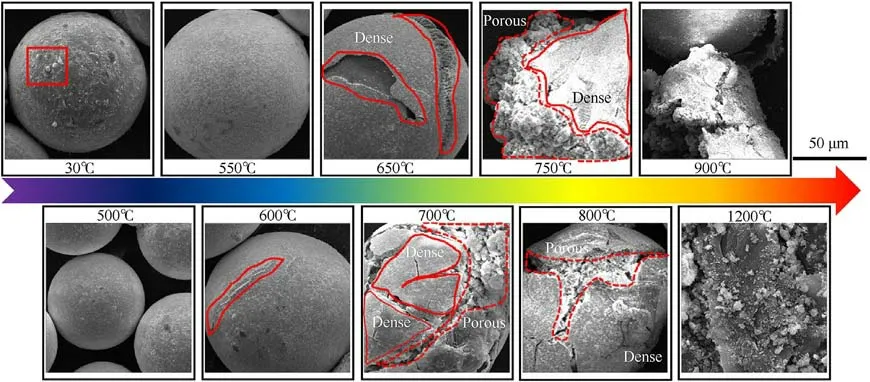
Fig.3.The morphology of the surface of Mg-Gd alloy after the heating at 500,550,600,650,700,750,800,900,and 1200 °C under O2 via SEM.The heating rate was 10 K/min.The magnification was 5000 times.Detailed morphologies were shown in Figs.S1~S10.

Fig.4.The EDS Results of Mg-Gd alloy after the heating at 600,650,700,750,800,900 and 1200 °C under O2 via SEM-Mapping.The heating rate was 10 K/min.The magnification was 5000 times.The EDS Results from 30 to 1200 °C were depicted in Fig.S11.
3.3.TG-DSC results of MGTV reacting in air
During Mg/Teflon/Viton (MTV), a conventional ignition charge and infrared decoy, burning in air, the fuel could be oxidized by both F and O.However,in the recent detailed investigation,in MTV composite, the fluorination of Mg could form a dense MgF2shell[17],As the result,the oxidation temperature of the exceeded Mg is much higher than that of pure Mg.This phenomenon also appeared in Viton coated Mg composite [18] and Mg-Al alloy/Teflon/Viton composite (MATV).However, in the case of Mg-Gd alloy/Teflon/Viton (MGTV), this obstructed oxidation of the exceeded Mg-Gd alloy particle did not appear [15].This feature requires further research.
Herein, to investigate the reaction of MGTV in air, the thermal activity of MGTV reacting in air was firstly investigated via TG-DSC.The results were shown in Fig.5.
As depicted in Fig.5,the reactions of MGTV in air under 5-30 K/min exhibited a similar pattern to MTV:nearly 50%mass losses by the temperature of 600°C and mass increases from 650 to 1000°C.
The mass losses by 600°C from 45.0%to 50.3%, while the mass increases from 650 to 1000°C decreased from 22.5%to 7.4%as the heat rate increasing from 5 to 30 K/min.According to previous researches [15,17], the mass loss by 600°C was due to the fluorination of Mg-Gd alloy and the mass increase was due to the oxidation of the exceeded alloy with air.
Noteworthily, in Fig.5(c), under each heating rate from 5 to 30 K/min, the mass increases of the oxidation of the exceeded Mg-Gd alloy included a minor mass increase (2.7%-5.0%) and a major mass increase (18.4%-3.4%).These minor mass increases were co-relating to the minor exothermic peaks (1) in Fig.5(d),respectively,when the major mass increases were co-relating to the major exothermic peaks (2&3).The onset temperatures, peak temperatures,ending temperatures,and co-relating mass increases were listed in Table 2.
According to Table 2, the results suggested that the oxidation behavior of the exceeded Mg-Gd alloy in MGTV was entirely different from that of pure Mg-Gd alloy (Fig.1&Table 1).Pure Mg-Gd alloy could be completely oxidized from 10 to 25 K/min.On the contrary,the oxidation of the exceeded Mg-Gd alloy in MGTV could be influenced by the heating rate, since the total mass increase was only 7.3% at 30 K/min.

Fig.5.The TG-DSC curves of the reaction of MGTV at 5,10,15, 20, 25, and 30 K/min under the atmosphere of Air: (a) and (b) were the curves of TG-DSC from 300 to 1000 °C,respectively; (c) and (d) were the curves of TG-DSC from 700-1000 °C of TG and DSC, respectively.

Table 2 The exothermic and mass-increase patterns of the reaction of MGTV in air under different heating rate.
Usually, the reaction rates are related to dα/dt.In the case of reactions investigated via TG-DSC,the oxidation rates are related to the DTG curves.However,in the case of MGTV,due to the mass of the exceeded Mg-Gd alloy after its fluorination was uncertain, it brought the difficulty of comparing the oxidation rate of the exceeded Mg-Gd alloy in MGTV and the pure alloy by dα/ dt.However,if assuming the exceeded alloy in MGTV was completely oxidized, when the pure alloy was also completely oxidized, α of both two oxidation reactions could be assumed as 1, and the oxidation rate could only be related to the interval of the whole oxidation.
Therefore, according to Table 1, the interval of the whole oxidation of Mg-Gd alloy at 5 K/min was 30°C, that at 30 K/min was 147°C.Meanwhile, according to Table 2, the interval of the whole oxidation of the exceeded alloy in MGTV at 5 K/min was 248°C, 8 times slower than the pure alloy.At 30 K/min, it was 350°C, 1.38 times slower than the pure alloy.These results suggested the oxidation rate of the exceeded alloy was much lower than the pure alloy.
On the other hand, according to Ref.[17], the onset oxidation temperature of the exceeded Mg in MTV was 132°C higher than that of the pure Mg.Moreover, the similar impediments both occurred in Viton coated Mg particle[18]and MATV.It was due to the formation of MgF2, which was a dense layer surrounding the fuel particle and further impede the reaction between the fuel and air.However, the onset temperatures of the oxidation of the exceeded Mg-Gd alloy was from 664°C(5 K/min),7°C higher than that of the pure alloy (Table 1).At 30 K/min, the impediment increased to 79°C, which was still lower than the impediment in MTV.It suggested the impediment of the dense MgF2shell in MGTV was weaker than that in MTV.
In conclusion,the reaction of MGTV in air could be considered as the fluorination of Mg-Gd alloy and the oxidation of the exceeded Mg-Gd alloy.After the fluorination, the onset oxidation temperature of the exceeded alloy was closed to that of the pure alloy.Mostimportantly, the oxidation rate of the exceeded alloy was much lower than the pure alloy.
3.4.The surface morphologies of MGTV reacting in air
To discuss the impact of the fluorination of Mg-Gd alloy on its further oxidation with air, the surface morphologies and element distribution of MGTV reacting in air was thoroughly conducted via SEM-Mapping-EDS.The surface morphologies of MGTV reacting at designated temperatures were shown in Fig.6.
The surface morphologies of MGTV reacting at designated temperatures in air were as depicted in Fig.6.At 30°C, Mg-Gd alloy particle was surrounded by Teflon.By the temperature of 300°C, this morphology did not significantly change.From 400 to 500°C,due to the decomposition of Teflon and Viton,the surface of the alloy particle was craggy.At the temperature of 600°C, the surface of the alloy particle was smooth and flat, suggesting the decomposition of the fluoropolymers completed and the fluorination of the alloy finished.At 700°C,the surface of the alloy was still flat, while a hole appeared on the surface.The hole suggested a shell was formed and broke.At 800°C,the shell completely broke,exposing its core.This shell-core structure was also observed at 900°C.However, at 1000°C, the core was completely oxidized,exhibiting its porous morphology.As temperature rose to 1100 and 1200°C, only the fragments of the broken shell were observed.
According to the hole formed on the shell, the core-shell structure was observed at 700°C.However, the shell on the pure Mg-Gd alloy was formed by 650°C,50°C lower than that in MGTV composite.A detailed investigation was conducted on the partial surface morphology of the alloy from 600 to 900°C.Furthermore,the core-shell structure of the residue of MGTV reacting in air at 900°C was also investigated.
The partial surface morphologies of Mg-Gd alloy oxidation and MGTV reacting in air at 700°C were shown in Fig.7(a).On the surface of the pure alloy,a few of sticks(mean length:0.29 μm)and several nodes(mean diameter:0.18 μm)were detected,while only nodes (mean diameter: 0.38 μm) were observed on the surface of the alloy in MGTV.These sticks were not appeared on the surface of Mg, while the nodes did [17].It suggested that the sticks could be due to the oxidation of Gd or Mg5Gd [16], while the nodes on the particle in both Mg-Gd alloy and MGTV was MgO.
As the temperature rose to 800°C,the sticks grew more on the surface of Mg-Gd alloy, and its mean length was 0.43 μm, 48%longer than that at 700°C.Meanwhile,the diameter of the nodes on its surface was 0.35 μm,94%bigger than that at 700°C.On the other hand, the surface of the alloy in MGTV was covered by countless nodes,of which mean diameter was 0.25 μm.These nodes piled up,forming a porous surface morphology.
At 900°C,on the surface of the alloy,sticks continued growing,the length of the sticks was 1.88 μm and the width grow to the maximum of 0.39 μm.Interestingly, none node was observed,replaced by numerous cubes.The mean diameter of these cubes was 0.18 μm.On the other hand,the surface of the shell of the alloy in MGTV was porous.Furthermore, the shell thickness was calculated as 1.60 μm.
The results showed an entirely different morphology-changing pattern.On the surface of Mg-Gd alloy, besides the growing MgO nodes, the oxidation products of Gd or Mg5Gd, also grow.On the other hand,only nodes were observed on the surface of the alloy in MGTV from 700 to 900°C.The amount-growing nodes further led the porous surface of the shell.Meanwhile, this shell was 37%thinner than the shell formed in MTV composite [17].
Furthermore, the surface element distribution of the alloy in MGTV reacting in air was investigated via SEM-Mapping-EDS.
The tendencies of the element distributions on the surface of Mg-Gd alloy when MGTV reacting in air were depicted in Fig.8.At 30°C,due to F concentrating in Teflon and Viton,Mg and Gd were both unevenly distributed on the alloy surface.This pattern did not significantly change until 500°C.At 500°C, F was simultaneously distributed on the surface of the alloy (A1′′) and the fluoropolymers.Meanwhile,Mg and Gd co-existed in the same area(A1 and A1′).It suggested the fluorination of Mg-Gd alloy underwent.
At 600°C, since the fluoropolymers completely decomposed, F covered the whole surface of the alloy and the fluorination of the alloy completed.Meanwhile, the concentration of O on the alloy surface(A2)was not higher than that in the background,suggesting the oxidation of the alloy did not begin.The similar pattern (A3)was also observed at 700°C.
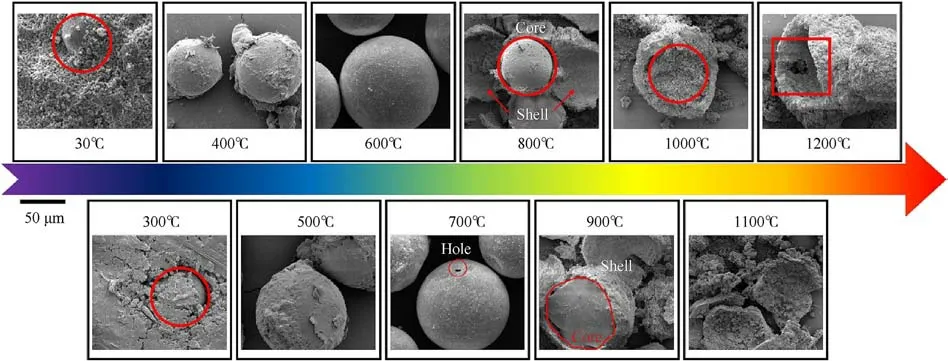
Fig.6.The surface morphologies of MGTV after the heating at 300, 400, 500, 600, 700, 800, 900, 1000, 1100 and 1200 °C in Air via SEM.The heating rate was 10 K/min.The magnification was 5000 times.Detailed morphologies were shown in Figs.S12~S22.
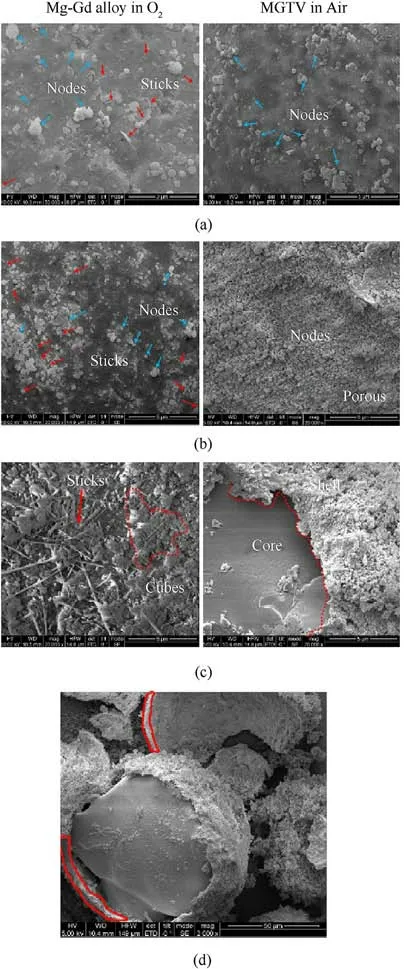
Fig.7.The partial surface morphologies of Mg-Gd alloy oxidizing and MGTV reacting in air at(a)700 °C;(b)800 °C;(c)900 °C;(d)Estimation area of the shell thickness of MGTV at 900 °C via Nano Measurer 1.2.The heating rate was 10 K/min.
However, at 800°C, the concentration of F on the alloy surface decreased (A4′′).Meanwhile, concentration of O significantly increased (A4′′′), suggesting that the oxidation of the alloy began.Furthermore, Mg was evenly distributed in A4.Interestingly, the distributions of Gd and F were not evenly distributed.In A4′, Gd aggregated below C1, while F assembled below C2 in A4′′.The aggregation Gd could be co-related to the aggregation of Gd during the oxidation of pure Mg-Gd alloy (Fig.4).
As the temperature rose to 900°C, the concentration of F continued decreasing (A5′′), while that of O continued increasing(A5′′′).It suggested the oxidation of the alloy continued.Meanwhile, Gd aggregated in C3.Due to the low concentration of F, the distribution pattern of F was unclear.These similar distribution patterns were also observed at 1000°C.However, at 1100°C and 1200°C, the concentration of F and Gd both decreased to 0.The decrease tendency of F was also observed in Ref.[17].
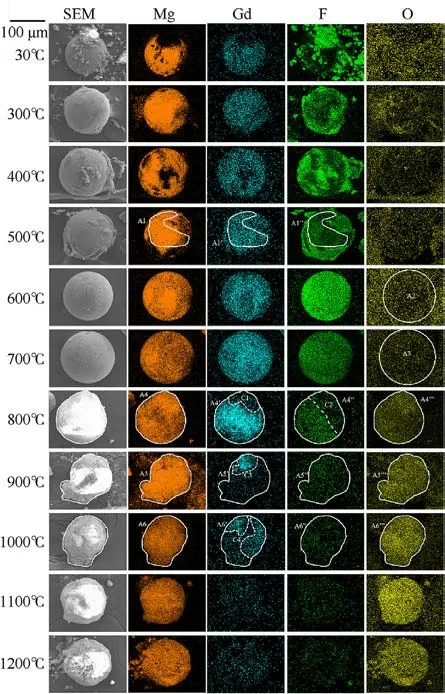
Fig.8.The EDS results of MGTV after the heating at 300,400,500,600,700,800,900,1000,1100 and 1200 °C under air via SEM-EDS-Mapping.The heating rate was 10 K/min.The magnification was 5000 times.
To verify the decreases of Gd and F and increase of O, EDS was simultaneously conducted on the surface of the alloy.
As shown in Fig.9,the atomic%(at%)of Mg decreased from 400 to 500°C, at% of F increased, simultaneously.It was due to the decomposition of Teflon transferring F to the surface of Mg-Gd alloy.At 700°C, the at% of F began decreasing, and it dropped to 0 at 900°C.From the temperature of 500-1200°C, the at% of O increased from 3.02% to 40.82%.Furthermore, the at% of Gd began to increase at 500°C, and reached to the maximum of 4.53% at 700°C,the increase was due to the aggregation of Gd,the at%of Gd on the surface increased.Later, the at% of Gd decreased to 0 at 1200°C.The EDS results consisted with the aforementioned results.
Therefore, during the reaction MGTV in air, F was transferred from the fluoropolymers to the alloy surface, and MgF2shell was firstly formed.From 700°C, O generally concentrated on the alloy surface, and the exceeded alloy was generally oxidized.The precipitation and oxidation of Gd or Mg5Gd could form a stickmorphology on the surface of pure alloy, which did not appear on the alloy surface in MGTV.Instead, the porous MgO appeared on the alloy surface in MGTV.Most-importantly,the thickness of MgF2shell in MGTV was thinner than that in MTV.It could lead to the lower onset oxidation temperature.

Fig.9.The atomic%of Mg,Gd,F and O on the surface of MGTV during the oxidation in Air.
3.5.The product formation of MGTV reacting in air
Due to its deeper depth of detection,X-ray diffraction(XRD)was conducted on the residue of MGTV after heating at 600, 700, 800 and 1000°C in air for the detailed investigation on the product formations of MGTV reacting in air.The result was shown in Fig.10.
As depicted in Fig.10,Mg,MgF2,GdOF,Gd2O3were detected.In details, the peaks at 32°, 34°, 38°and 47°were assigned to Mg(JCPDS#35-0821,marked with hollow rhombus),the peaks at 27°,35°, 41°and 53°were assigned to MgF2(JCPDF# 70-2268, indicated with black dots),the peaks at 27.6°,28.0°,32.5°,46.4°,47.0°,and 55°were assigned to GdOF (JCPDS# 50-0569, indicated with hollow square),and the peaks at 28.6°,33.1°,47.6°,and 56.5°were assigned to Gd2O3(cubic phase, JCPDS# 12-0797, indicated with solid rhombus).
In the XRD result of Mg-Gd alloy particle, besides the peaks of Mg,peaks(1-6)were not assigned to Gd,which could be due to the diffraction of Mg5Gd.After heating at 600°C, these peaks with MgF2peaks were repeatedly detected in the residue.It suggested MgF2was formed at 600°C, yet Mg5Gd were not precipitated and oxidized.At 700°C, peaks (1-6) were not detected.Instead, GdOF and MgO were simultaneously detected.It suggested the oxidation of the exceeded Mg-Gd alloy began at 700°C, and GdOF was generated.At 800°C,Gd2O3and MgO were detected along with Mg,GdOF and MgF2.The saturated oxidation products,Gd2O3and MgO,suggested the further oxidation of the alloy.At 1000°C,Mg was not detected, suggesting the completion of the oxidation of Mg-Gd alloy.Noteworthily, the peaks of MgF2at 700°C were smaller than these at 600°C, later, only the sole peak at 41°of MgF2was observed at 800°C, when MgF2was not detected at 1000°C.This pattern consisted with the decrease of at% of F (Fig.9).
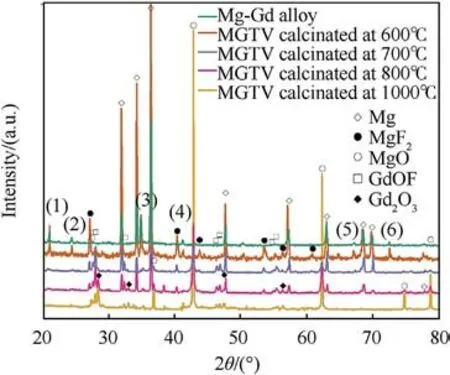
Fig.10.The XRD results of the residues of MGTV oxidized at 600, 700 [17], 800 and 1000 [17] °C, respectively.
Conclusively, during the reaction of MGTV in air, MgF2was firstly generated at 600°C.Then,GdOF and MgO were generated at 700°C.Gd2O3and MgO were not generated until the temperature rose to 800°C.Mg was completely oxidized at 1000°C.Interestingly,after heating at 700°C,Mg5Gd phase disappeared and GdOF phase was generated.It suggesting only after the precipitation of Mg5Gd, Gd could participate the reaction, and firstly generate GdOF.
3.6.Activities of GdOF in the residue of MGTV after calcination at 700 °C
According to the TG-DSC result of Mg/Teflon/Viton(MTV)in air[17], which also included the fluorination of Mg and the oxidation of exceeded Mg, several common features could be concluded.Commonly,the fluorinations of Mg and Mg-Gd alloy both began at 250°C and ended by 600°C.
On the other hand, the differences of the reaction of MTV and MGTV in air were the oxidation of the exceeded fuel.Overall,for the oxidation of the exceeded Mg-Gd alloy, there were a minor and two major exothermic peaks and co-relating mass increases under 5-25 K/min, respectively.Only a minor and major exothermic peaks and co-relating mass increase were observed at 30 K/min.
However, for the oxidation of exceeded Mg, here were three exothermic peaks and co-relating mass increases under 5-30 K/min,respectively.The aforementioned information under different heating rate of MTV was listed in Table 3.
According to Tables 2 and 3, the oxidation processes of the exceeded Mg-Gd alloy was different from that of exceeded Mg in MTV.Firstly, at 5 K/min, the onset temperature of the first sharp exothermic peak of the oxidation of the exceeded Mg-Gd alloy,i.e.peak 2 in Table 2, was 51°C higher than the onset temperature of peak 1 in MTV.At 30 K/min, this difference increased to 58°C.Furthermore,at 5 K/min,total mass increase from 650 to 1000°C of the oxidation of the exceeded Mg-Gd alloy was 21.0%,32.7%lower than that of Mg.At 30 K/min,the decrease was 49.3%.These mostly due to the better oxidation resistance of Mg-Gd alloy.The aforementioned protective oxide shell could further impede the oxidation of the alloy.
Noteworthily, before the first sharp exothermic peak of the oxidation of the exceeded Mg-Gd alloy(peak 2 of Table 2),a minor exothermic peak (peak 1 in Table 2), co-relating to a minor mass increase (Interval 1 of Table 2), was observed at each heating rate.However, on the TG curve of the oxidation of the exceeded Mg in MTV, only a minor mass increase (Interval 1 of Table 3) was observed, no heat release was detected.Furthermore, during Interval 1, only a 1.09%-1.68% mass increase was observed in MTV,while a 2.52%-3.09% mass increase was observed in MGTV.It suggested during the Interval 1, more heat was released and more mass increased in the case of the oxidation of exceeded Mg-Gd alloy.
According to aforementioned XRD results, GdOF and MgO was generated in MGTV during this interval.Since GdOF was the new phase detected in the residue of MGTV[17]reacting at 700°C in air(referred as Residue A),the existence of GdOF could be the reason of the lower onset temperature and more heat release of the oxidation of exceeded Mg-Gd alloy.Therefore,Residue A was added into Mg/Teflon mixture (MT), forming a new composite, referred as MTRA,and the impact of Residue A on MT was investigated.
As shown in Fig.11,the reaction of MTRA was similar to MTV and MGTV,which also could be divided into the fluorination of the fuel and oxidation of the exceeded fuel.However, the onset oxidationtemperature of the exceeded fuel in MTRA was 619°C (Fig.11(c)),which was 47°C earlier than that in MGTV and much earlier than MTV.Furthermore,between 600 and 770°C,a 4.26%mass increase was observed in MTRA, while only 1.91%and 1.51%mass increases were observed in MGTV and MTV, respectively.It suggested that after adding 10% Residue A into MT, the oxidation of exceeded Mg was facilitated.
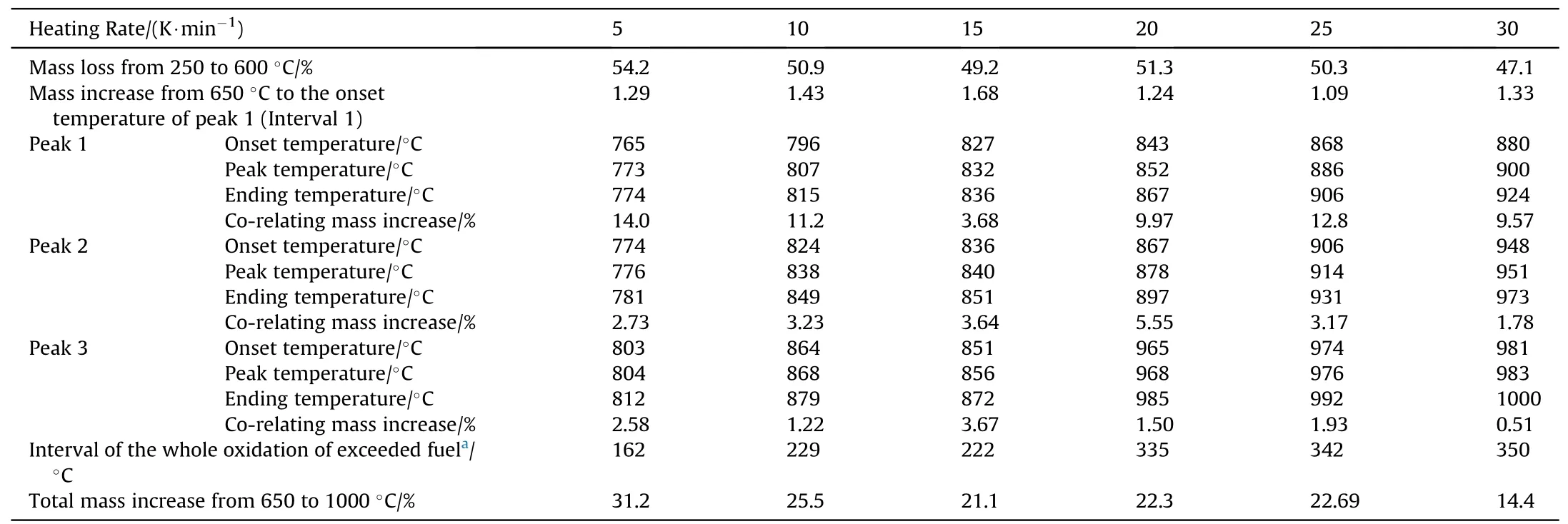
Table 3 The exothermic and mass-increase patterns of the reaction of MTV in air under different heating rate[17].
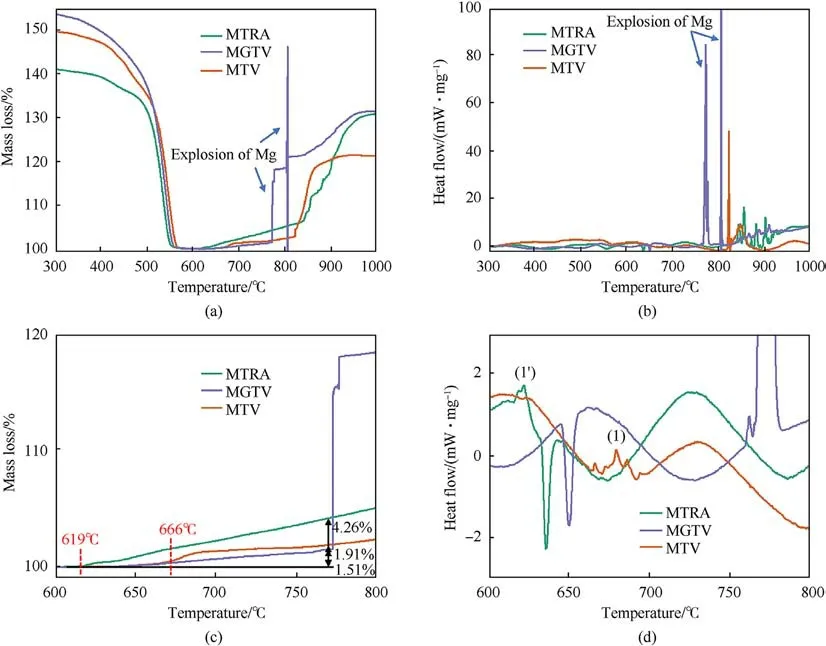
Fig.11.The TG-DSC curves of the reaction of MTRA at 5 K/min under the atmosphere of Air:(a)&(b)were the curves of TG-DSC from 300 to 1000 °C,respectively;(c)and(d)were the curves of TG-DSC from 600-800 °C of TG and DSC, respectively.As control, the TG-DSC curves of the reaction of MTV [17] and MGTV were also exhibited.
On the other hand, on the DSC curve of MTRA (Fig.11(d)), a series of minor exothermic peaks (1′) were firstly observed at 620°C,followed by the melting peak of the alloy.A series of minor peaks(1)were also observed in MGTV,respectively,while it did not appear in MTV.Peaks (1) & (1′) suggested an intriguing reaction underwent due to the existence of GdOF.Noteworthily, the peak temperatures of the peaks (1’) were nearly 100°C lower than the peaks(1).It also suggested that in MTRA,the oxidation of exceeded Mg was further facilitated than the exceeded Mg-Gd alloy in MGTV.
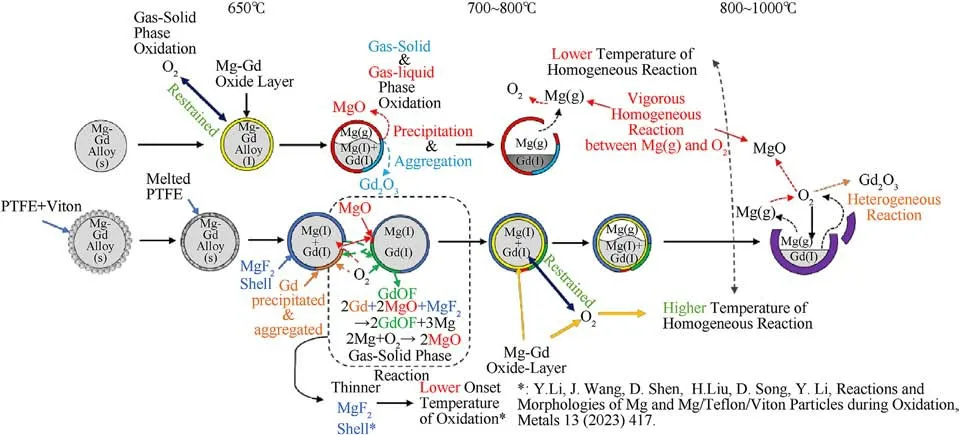
Fig.12.The surface reaction mechanisms of the oxidation of Mg-Gd alloy and the reaction of MGTV in air.
The results showed that after adding Residue A into MT, the onset oxidation temperature of the exceeded Mg was significantly lower than that of MTV, even lower than MGTV.Since Residue A was uniquely consist of GdOF, it was a reasonable suspicion that GdOF was the reason of the facilitated oxidation of the exceeded Mg.
However, even during the reactions of MTRA and MGTV, GdOF existed in both two composites, the onset temperature of the exceeded fuel in MTRA was lower than that in MGTV.It was because in MGTV, GdOF was not generated until the temperature rose to 700°C and Gd was generated from the precipitation of Mg5Gd phase.
Since Teflon and Viton have been completely decomposed at 600°C [15], the sole F source in MGTV at 700°C was MgF2.Therefore, F in GdOF generated at 700°C originated from MgF2,suggesting that the activity of Gd was higher than Mg.Herein,two possible reactions underwent during Interval 1 of MGTV:
However,the sole F source in MGTV at 700°C was limited in the MgF2shell,leading to the lack of F.As a result,Gd was not able to be completely fluorized to GdF3.On the contrary,O existed both in the atmosphere and MgO.Therefore,the generation of GdOF could be:
Reasonably, the reduction of MgF2on the surface led to the thinner MgF2shell and aforementioned lower onset oxidation temperature.
Therefore, GdOF, the unique product of MGTV reacting in air,caused the lower onset oxidation temperature of the exceeded alloy in MGTV.Furthermore, adding GdOF into MT could significantly reduce the onset oxidation temperature of the exceeded Mg.Furthermore, in MGTV, GdOF was generated after Gd was generated from precipitated Mg5Gd.The activity of Gd could be possibly higher than Mg,and MgF2was reduced.As a result,the MgF2shell was thinner and the onset temperature of the exceeded fuel in MGTV was higher than that in MTV.
Herein, the surface reaction mechanisms of the oxidation of Mg-Gd alloy and the reaction of MGTV in air were exhibited in Fig.12.Firstly, in the case of the oxidation of Mg-Gd alloy, a protective oxide shell was formed on the surface of the alloy,restraining its further oxidation.This was a gas-solid phase reaction.As the alloy melted, Mg was firstly precipitated then vaporized, when Gd aggregated.Later, gaseous Mg torn the oxide shell apart and reacted with O2vigorously.Tremendous mass increase and heat release were generated by the homogenous oxidation of gaseous Mg.
On the hand, as MGTV reacting in air, a MgF2shell rather than oxide shell was firstly formed on the surface of the alloy.Later, as Gd precipitated and aggregated, MgO and GdOF were generated.This gas-solid phase reaction could thin the MgF2shell and lower the onset temperature of the oxidation of the exceeded alloy.Continuously,as the exceeded alloy oxidizing,the protective oxide shell was formed on the surface of the exceeded alloy, which impeded its oxidation.Eventually, Mg vaporized and the homogenous oxidation of gaseous Mg began.
4.Conclusions
A thorough investigation on the morphologies of Mg-Gd alloy and Mg-Gd alloy/Teflon/Viton (MGTV) during oxidations was conducted.During the oxidation of Mg-Gd alloy,a protective oxide layer was formed,elevating the oxidation temperatures of the alloy particle.
The reaction of MGTV included the fluorination of Mg-Gd alloy and the oxidation of the exceeded alloy.Despite of the protective feature of MgF2shell generated by the fluorination,the oxidation of the exceeded Mg-Gd alloy was not impeded.It was owning to the existence of GdOF.Therefore, a possible reaction mechanism was proposed:Gd could react with the MgF2shell and MgO,decreasing the shell thickness and generating GdOF.GdOF could further lower the oxidation temperature of the exceeded fuel both in Mg/Teflon and MGTV.
Mg-Gd alloy possesses a better oxidation resistance, while it could generate GdOF and facilitated the oxidation of the fuel.The fascinating oxidation properties of Mg-Gd alloy suggested their promising applications in energetic materials.
Declaration of competing interest
The authors declare that they have no known competing financial interests or personal relationships that could have appeared to influence the work reported in this paper.
Appendix A.Supplementary data
Supplementary data to this article can be found online at https://doi.org/10.1016/j.dt.2023.06.002.
- Defence Technology的其它文章
- Evolution of molecular structure of TATB under shock loading from transient Raman spectroscopic technique
- MTTSNet:Military time-sensitive targets stealth network via real-time mask generation
- Vulnerability assessment of UAV engine to laser based on improved shotline method
- Free-walking: Pedestrian inertial navigation based on dual footmounted IMU
- Investigation of hydroxyl-terminated polybutadiene propellant breaking characteristics and mechanism impacted by submerged cavitation water jet
- Estimation of surface geometry on combustion characteristics of AP/HTPB propellant under rapid depressurization

